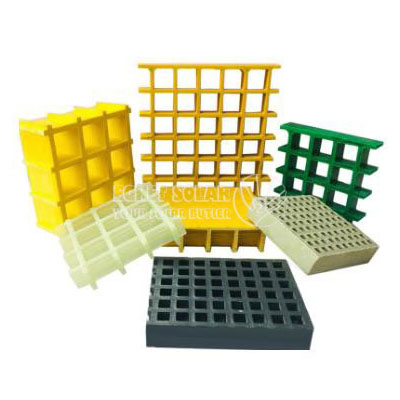Features and Characteristics of Fiberglass Walkways
2024-06-12
A fiberglass walkway, also known as a fiberglass grating walkway or FRP (Fiber Reinforced Polymer) walkway, is a durable and lightweight structure used in various industrial, commercial, and residential settings for pedestrian access, safety, and convenience. Fiberglass walkways are made from reinforced fiberglass materials, providing several advantages over traditional materials such as wood, steel, or concrete. Here's an overview of fiberglass walkways:
Features and Characteristics:
1. Fiberglass Construction:
- Fiberglass walkways are constructed using fiberglass reinforced with resins, resulting in a strong, durable, and corrosion-resistant structure.
2. Lightweight:
- Fiberglass walkways are significantly lighter than traditional materials such as steel or concrete, making them easier to transport, handle, and install.
3. High Strength-to-Weight Ratio:
- Despite being lightweight, fiberglass walkways offer high strength and load-bearing capacity, making them suitable for pedestrian traffic and light-duty applications.
4. Corrosion Resistance:
- Fiberglass is inherently resistant to corrosion from chemicals, moisture, and environmental factors, making fiberglass walkways ideal for use in harsh or corrosive environments such as chemical plants, wastewater treatment facilities, and coastal areas.
5. Non-Conductive:
- Fiberglass is non-conductive and does not conduct electricity, making fiberglass walkways safe for use in electrical and hazardous environments where electrical conductivity is a concern.
6. Slip Resistance:
- Fiberglass walkways can be manufactured with slip-resistant surfaces, such as textured or gritted finishes, to enhance traction and reduce the risk of slips and falls, especially in wet or slippery conditions.
7. UV Resistance:
- Fiberglass materials are resistant to ultraviolet (UV) radiation, ensuring long-term durability and color stability even when exposed to sunlight and outdoor conditions.
8. Low Maintenance:
- Fiberglass walkways require minimal maintenance compared to traditional materials, as they do not rust, corrode, or deteriorate over time. Routine cleaning with water and mild detergent is typically sufficient to maintain their appearance and performance.
9. Customizable Design:
- Fiberglass walkways are available in various sizes, shapes, and configurations to accommodate different site requirements, including straight sections, curves, angles, and transitions.
10. Easy Installation:
- Fiberglass walkways are often prefabricated and modular in design, allowing for quick and easy installation with standard tools and hardware. They can be installed on existing support structures or integrated into new construction projects.
Applications:
1. Industrial Facilities:
- Fiberglass walkways are commonly used in industrial plants, refineries, and chemical processing facilities for access platforms, catwalks, and elevated walkways where corrosion resistance and safety are paramount.
2. Water and Wastewater Treatment Plants:
- Fiberglass walkways are ideal for use in water treatment plants, sewage treatment facilities, and wastewater treatment plants, where exposure to chemicals, moisture, and corrosive environments is common.
3. Marine and Coastal Environments:
- Fiberglass walkways are well-suited for use in marine and coastal environments, including docks, piers, boardwalks, and waterfront structures, where they offer resistance to saltwater, moisture, and UV exposure.
4. Commercial and Municipal Buildings:
- Fiberglass walkways can be installed in commercial buildings, public facilities, and recreational areas for pedestrian bridges, elevated pathways, and access ramps where durability, safety, and aesthetic appeal are important.
5. Infrastructure and Transportation:
- Fiberglass walkways are used in transportation infrastructure such as bridges, overpasses, and pedestrian crossings to provide safe and durable pedestrian access routes, especially in areas prone to corrosion or environmental degradation.
Considerations for Installation:
1. Site Preparation:
- Ensure proper site preparation, including surface cleaning, leveling, and structural support, before installing fiberglass walkways to ensure stability and longevity.
2. Anchoring and Fastening:
- Use appropriate anchoring and fastening methods, such as bolts, clips, or adhesive bonding, to secure fiberglass walkways to supporting structures and prevent movement or displacement.
3. Safety Compliance:
- Ensure compliance with safety standards and regulations, including load-bearing capacity, slip resistance, and accessibility requirements, when designing and installing fiberglass walkways in public or commercial settings.
4. Professional Installation:
- Consider hiring experienced professionals or certified installers familiar with fiberglass walkway systems to ensure proper installation, alignment, and adherence to manufacturer specifications and warranty requirements.
5. Maintenance Planning:
- Develop a maintenance plan for regular inspection, cleaning, and upkeep of fiberglass walkways to prolong service life, prevent damage, and ensure continued safety and performance.
Conclusion:
Fiberglass walkways offer a durable, lightweight, and corrosion-resistant solution for pedestrian access, safety, and convenience in various industrial, commercial, and municipal applications.



